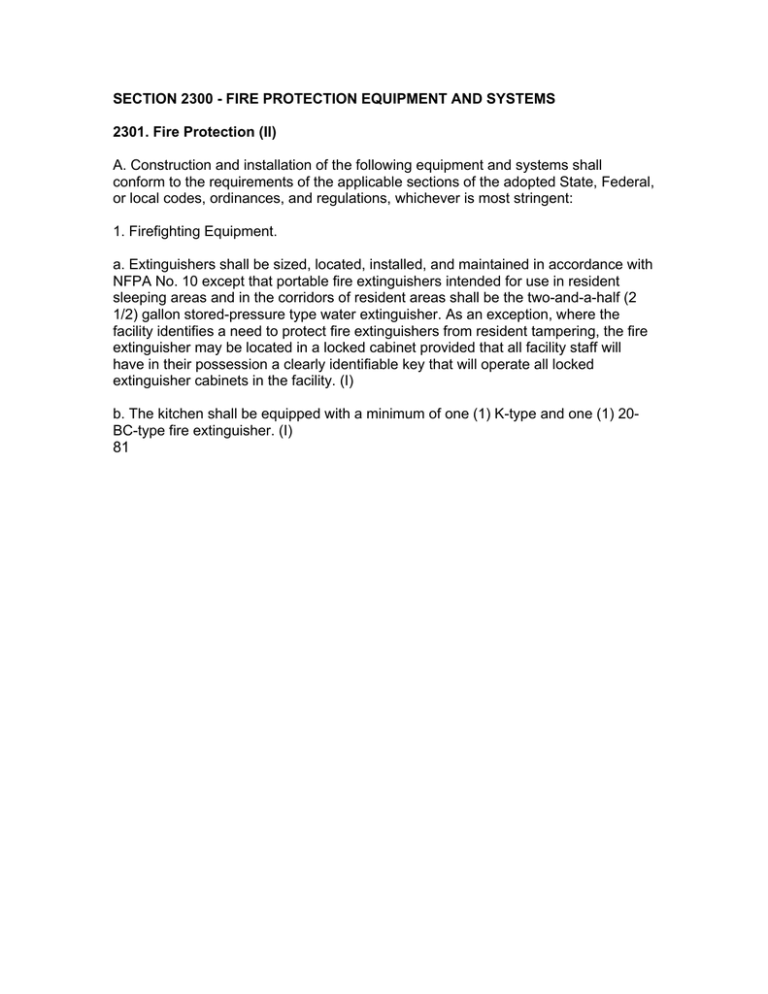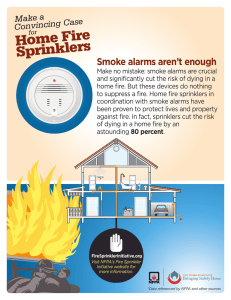SECTION 2300 - FIRE PROTECTION EQUIPMENT AND SYSTEMS
advertisement

SECTION 2300 - FIRE PROTECTION EQUIPMENT AND SYSTEMS 2301. Fire Protection (II) A. Construction and installation of the following equipment and systems shall conform to the requirements of the applicable sections of the adopted State, Federal, or local codes, ordinances, and regulations, whichever is most stringent: 1. Firefighting Equipment. a. Extinguishers shall be sized, located, installed, and maintained in accordance with NFPA No. 10 except that portable fire extinguishers intended for use in resident sleeping areas and in the corridors of resident areas shall be the two-and-a-half (2 1/2) gallon stored-pressure type water extinguisher. As an exception, where the facility identifies a need to protect fire extinguishers from resident tampering, the fire extinguisher may be located in a locked cabinet provided that all facility staff will have in their possession a clearly identifiable key that will operate all locked extinguisher cabinets in the facility. (I) b. The kitchen shall be equipped with a minimum of one (1) K-type and one (1) 20BC-type fire extinguisher. (I) 81 c. Each staff work area shall be equipped with a minimum of one (1) 2A:l0BC-type fire extinguisher. (I) d. To assure fire extinguishers remain functional, each shall be checked at least monthly by the facility. 2. Automatic Sprinkler Systems. 3. Fire Alarms. a. The alarm system shall cause the central re-circulating ventilation fans that serve the area(s) of alarm origination to cease operation and to shut the associated smoke dampers. b. Fire alarm pull-stations shall be at or near each staff work area and in other areas of the facility in accordance with NFPA 72. c. The fire alarm system shall have the main alarm panel installed at a location that is constantly attended by staff. An audible and visual trouble indicator shall be located where it can be observed by staff members. 4. Smoke Detectors. a. Smoke detectors shall be installed in all exit access corridors thirty (30) feet on center, no farther than fifteen (15) feet from any wall, and within five (5) feet of a smoke partition opening in accordance with NFPA 72 and the applicable sections of the adopted State, Federal, or local codes, ordinances, and regulations, whichever is most stringent. As an exception, where each resident room is protected by a smoke detector(s) and detectors are provided on both sides of the rated smoke and fire partitions, such corridor system will not be required on the resident room floors. b. Smoke detectors in resident rooms shall have a clearly visible indicator light in the corridor outside the door of the room to indicate when that smoke detector is activated. As an exception, when the fire alarm system is fully addressable, i.e., each detector is identifiable and locatable by its signal, and there are sufficient annunciator panel(s) such that travel distance in any hall to an annunciator panel does not exceed fifty (50) feet, and the annunciator panel will indicate the activated smoke detector by location, the light over the door in the hall is not required. c. All smoke detectors shall be electrically interconnected to the fire alarm system as well as to the hold-open devices on smoke doors and fire doors within a fire zone. d. Smoke and/or heat detection systems shall be installed within, but not limited to, the following spaces: assembly spaces, utility rooms, storage rooms, janitor closets, laundry rooms, kitchens, mechanical and electrical rooms. 82 5. Flammable Liquids. (I) a. The storage and handling of flammable liquids shall be in accordance with NFPA 30 and 99. b. Flammable liquids such as gasoline, oil, paints, solvents, shall be stored in an outside building or in a one-hour fire separated room opening to the outside. Mechanical or gravity ventilation for the room shall be taken from, and exhausted to, the outside. 6. Gases. a. Gases, i.e., flammable and nonflammable, shall be handled and stored in accordance with the provisions of NFPA 99 and 101. b. Installation, maintenance, and testing of piped gas systems shall meet the provisions of NFPA 99. c. Safety precautions shall be taken against fire and other hazards when oxygen is dispensed, administered, or stored. All cylinders shall be appropriately secured. As an exception, in “Smoke-Free” facilities where smoking is prohibited, and where the facility nonsmoking policy is strictly enforced, and where “Smoke-Free” signs are strategically placed at all major entrances, secondary “No Smoking” signs shall not be required in and in the vicinity of resident rooms where oxygen is being administered. “No Smoking” signs shall be required in and in the vicinity of resident rooms and all other areas of the facility where oxygen is being stored. (I) d. If used, clinical vacuum system installations shall be in accordance with the requirements of Compressed Gas Association publication regarding clinical vacuum systems. 7. Furnishings and Equipment. a. The physical plant shall be maintained free of fire hazards or impediments to fire prevention. b. No unvented fuel heaters shall be permitted in the facility. Portable electric heaters may be used for emergencies in accordance with South Carolina State Fire Marshal rules and regulations. c. Fireplaces and fossil-fuel stoves, e.g., wood-burning, shall have partitions or screens or other means to prevent burns. Fireplaces shall be vented to the outside. “Unvented” type gas logs are prohibited. Gas fireplaces shall have a remote gas shutoff within the room and not inside the fireplace. 83 d. Cubicle curtains, window dressings, portable partitions, wastebaskets, mattresses, and pillows shall be noncombustible, inherently flame-resistant, or treated or maintained flame-resistant in accordance with NFPA 701, Standard Methods of Fire Tests for Flame-Resistant Textiles and Films. As an exception, window blinds require no flame treatments. e. The facility shall comply with all current state laws and regulations concerning smoking in the facility, i.e., S.C. Code Ann. Section 44-95-20 et seq. (1976, as amended). B. Fire detection, alarm and extinguishing systems shall be inspected, tested, and maintained in accordance with the requirements of the applicable sections of the adopted State, Federal, or local codes, ordinances, and regulations, whichever is most stringent. (I)




